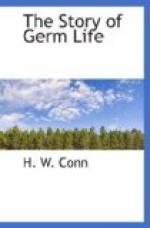CHAPTER V.
Parasitic bacteria and their relation to disease.
Perhaps the most universally known fact in regard to bacteria is that they are the cause of disease. It is this fact that has made them objects of such wide interest. This is the side of the subject that first attracted attention, has been most studied, and in regard to which there has been the greatest accumulation of evidence. So persistently has the relation of bacteria to disease been discussed and emphasized that the majority of readers are hardly able to disassociate the two. To most people the very word bacteria is almost equivalent to disease, and the thought of swallowing microbes in drinking water or milk is decidedly repugnant and alarming. In the public mind it is only necessary to demonstrate that an article holds bacteria to throw it under condemnation.
We have already seen that bacteria are to be regarded as agents for good, and that from their fundamental relation to plant life they must be looked upon as our friends rather than as our enemies. It is true that there is another side to the story which relates to the parasitic species. These parasitic forms may do us direct or indirect injury. But the species of bacteria which are capable of doing us any injury, the pathogenic bacteria, are really very few compared to the great host of species which are harmless. A small number of species, perhaps a score or two, are pathogenic, while a much larger number, amounting to hundreds and perhaps thousands of species, are perfectly harmless. This latter class do no injury even though swallowed by man in thousands. They are not parasitic, and are unable to grow in the body of man. Their presence is entirely consistent with the most perfect health, and, indeed, there are some reasons for believing that they are sometimes directly beneficial to health. It is entirely unjust to condemn all bacteria because a few chance to produce mischief. Bacteria in general are agents for good rather than ill.




